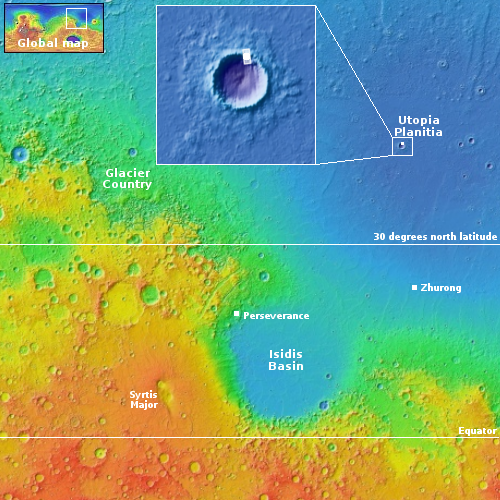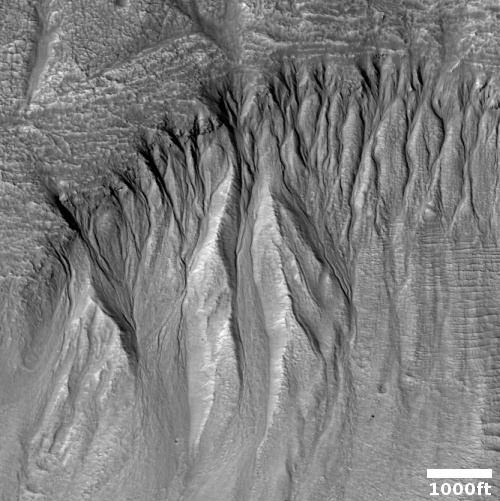Monitoring the gullies on Mars for changes
Cool image time! The picture to the right, cropped and reduced to post here, was taken on March 24, 2023 by the high resolution camera on Mars Reconnaissance Orbiter (MRO) as part of a long term monitoring program of the many Martian gullies scientists have found above 30 degrees north latitude on a variety of slopes.
Martian gullies are small, incised networks of narrow channels and their associated downslope sediment deposits, found on the planet of Mars. They are named for their resemblance to terrestrial gullies. First discovered on images from Mars Global Surveyor, they occur on steep slopes, especially on the walls of craters. Usually, each gully has a dendritic alcove at its head, a fan-shaped apron at its base, and a single thread of incised channel linking the two, giving the whole gully an hourglass shape. They are estimated to be relatively young because they have few, if any craters.
…Most gullies occur 30 degrees poleward in each hemisphere, with greater numbers in the southern hemisphere. Some studies have found that gullies occur on slopes that face all directions; others have found that the greater number of gullies are found on poleward facing slopes, especially from 30° to 44° S. Although thousands have been found, they appear to be restricted to only certain areas of the planet. In the northern hemisphere, they have been found in Arcadia Planitia, Tempe Terra, Acidalia Planitia, and Utopia Planitia. In the south, high concentrations are found on the northern edge of Argyre basin, in northern Noachis Terra, and along the walls of the Hellas outflow channels.
Orbital data has identified almost 5,000 gullies on Mars. Based on their shape and the Martian climate, scientists generally think these gullies were formed by some form of water flow, possibly coming from an underground aquifer at their top.

The white dot in the inset on the overview map to the right marks the location of these gullies, inside the northern interior slopes of 29-mile-wide Nier Crater. Since the first discovery of these gullies by Mars Global Surveyor in 2006, scientists have been monitoring them over and over to see if they would change seasonally due to water seepage from underground. Nier Crater itself has been photographed by MRO’s high resolution camera more than a dozen times, with the particular location above having been imaged previously in 2010 and 2019.
Few changes have been seen, however, and those have generally been attributed to a variety of rockfalls caused by the seasonal temperature shifts, not water seepage from below. It is now thought that if water caused these gullies, it did so in the past, when Mars’ changing rotational tilt made the climate different.
Nier Crater however is a good target for future exploration and research, because the floor of this crater is deeper than all but one other crater between 25 degrees south and 45 degrees north latitudes, lying about 6,500 feet below its rim. That deep elevation would provide unusual conditions for studying the Martian atmosphere.
On Christmas Eve 1968 three Americans became the first humans to visit another world. What they did to celebrate was unexpected and profound, and will be remembered throughout all human history. Genesis: the Story of Apollo 8, Robert Zimmerman's classic history of humanity's first journey to another world, tells that story, and it is now available as both an ebook and an audiobook, both with a foreword by Valerie Anders and a new introduction by Robert Zimmerman.
The print edition can be purchased at Amazon or from any other book seller. If you want an autographed copy the price is $60 for the hardback and $45 for the paperback, plus $8 shipping for each. Go here for purchasing details. The ebook is available everywhere for $5.99 (before discount) at amazon, or direct from my ebook publisher, ebookit. If you buy it from ebookit you don't support the big tech companies and the author gets a bigger cut much sooner.
The audiobook is also available at all these vendors, and is also free with a 30-day trial membership to Audible.
"Not simply about one mission, [Genesis] is also the history of America's quest for the moon... Zimmerman has done a masterful job of tying disparate events together into a solid account of one of America's greatest human triumphs."--San Antonio Express-News
Cool image time! The picture to the right, cropped and reduced to post here, was taken on March 24, 2023 by the high resolution camera on Mars Reconnaissance Orbiter (MRO) as part of a long term monitoring program of the many Martian gullies scientists have found above 30 degrees north latitude on a variety of slopes.
Martian gullies are small, incised networks of narrow channels and their associated downslope sediment deposits, found on the planet of Mars. They are named for their resemblance to terrestrial gullies. First discovered on images from Mars Global Surveyor, they occur on steep slopes, especially on the walls of craters. Usually, each gully has a dendritic alcove at its head, a fan-shaped apron at its base, and a single thread of incised channel linking the two, giving the whole gully an hourglass shape. They are estimated to be relatively young because they have few, if any craters.
…Most gullies occur 30 degrees poleward in each hemisphere, with greater numbers in the southern hemisphere. Some studies have found that gullies occur on slopes that face all directions; others have found that the greater number of gullies are found on poleward facing slopes, especially from 30° to 44° S. Although thousands have been found, they appear to be restricted to only certain areas of the planet. In the northern hemisphere, they have been found in Arcadia Planitia, Tempe Terra, Acidalia Planitia, and Utopia Planitia. In the south, high concentrations are found on the northern edge of Argyre basin, in northern Noachis Terra, and along the walls of the Hellas outflow channels.
Orbital data has identified almost 5,000 gullies on Mars. Based on their shape and the Martian climate, scientists generally think these gullies were formed by some form of water flow, possibly coming from an underground aquifer at their top.

The white dot in the inset on the overview map to the right marks the location of these gullies, inside the northern interior slopes of 29-mile-wide Nier Crater. Since the first discovery of these gullies by Mars Global Surveyor in 2006, scientists have been monitoring them over and over to see if they would change seasonally due to water seepage from underground. Nier Crater itself has been photographed by MRO’s high resolution camera more than a dozen times, with the particular location above having been imaged previously in 2010 and 2019.
Few changes have been seen, however, and those have generally been attributed to a variety of rockfalls caused by the seasonal temperature shifts, not water seepage from below. It is now thought that if water caused these gullies, it did so in the past, when Mars’ changing rotational tilt made the climate different.
Nier Crater however is a good target for future exploration and research, because the floor of this crater is deeper than all but one other crater between 25 degrees south and 45 degrees north latitudes, lying about 6,500 feet below its rim. That deep elevation would provide unusual conditions for studying the Martian atmosphere.
On Christmas Eve 1968 three Americans became the first humans to visit another world. What they did to celebrate was unexpected and profound, and will be remembered throughout all human history. Genesis: the Story of Apollo 8, Robert Zimmerman's classic history of humanity's first journey to another world, tells that story, and it is now available as both an ebook and an audiobook, both with a foreword by Valerie Anders and a new introduction by Robert Zimmerman.
The print edition can be purchased at Amazon or from any other book seller. If you want an autographed copy the price is $60 for the hardback and $45 for the paperback, plus $8 shipping for each. Go here for purchasing details. The ebook is available everywhere for $5.99 (before discount) at amazon, or direct from my ebook publisher, ebookit. If you buy it from ebookit you don't support the big tech companies and the author gets a bigger cut much sooner.
The audiobook is also available at all these vendors, and is also free with a 30-day trial membership to Audible.
"Not simply about one mission, [Genesis] is also the history of America's quest for the moon... Zimmerman has done a masterful job of tying disparate events together into a solid account of one of America's greatest human triumphs."--San Antonio Express-News



Here on Earth I’ve never seen a gully shaped like these that wasn’t formed by the flow of liquid; always water here on Earth. Those gullies are almost certainly a preserved water-shaped form. Glacial forms are almost always a U-shaped channel, at least here on Earth.
Thank you once again for some fascinating images.